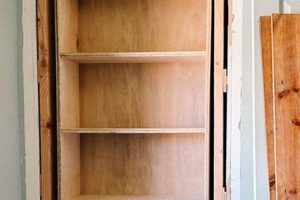A concealed entrance crafted by an individual, integrating a shelving unit as a functional and disguised access point, provides an unconventional method of room separation. This type of project involves modifying a standard bookcase or constructing one from raw materials to serve as a pivotable barrier. The final product appears to be a normal bookshelf, while seamlessly blending into the wall when closed.
The practice of concealing entryways within furniture elements introduces an element of intrigue and enhances spatial efficiency. Throughout history, secret passages and hidden rooms have served both functional and symbolic roles, from protecting valuables to offering discreet routes. This type of design provides both a visual appeal and also a good alternative if space is limited.
The process typically involves careful planning, precise measurements, and the selection of appropriate hardware to ensure smooth operation and secure concealment. Careful considerations include hinge selection, weight distribution, and the locking mechanism. These construction techniques provide a creative alternative to a traditional door.
Construction Guidance
The following points serve as guidelines for those undertaking a project involving a disguised shelving entrance. Implementation of these recommendations contributes to a successful and secure outcome.
Tip 1: Structural Integrity: The support structure must withstand the combined weight of the shelving unit, its contents, and the dynamic forces exerted during operation. Reinforce the frame with steel or hardwood to prevent warping or sagging.
Tip 2: Hinge Selection: Utilize heavy-duty pivot hinges designed to bear substantial weight. Ensure the hinge mechanism allows for smooth, quiet operation and remains concealed when the entrance is closed.
Tip 3: Frame Alignment: Precise frame alignment is essential for seamless integration with the surrounding wall. Employ shims and laser levels to achieve a perfectly flush fit, minimizing visible gaps.
Tip 4: Locking Mechanism: Implement a robust locking system that prevents unauthorized access. Magnetic locks or concealed bolt mechanisms offer secure and discreet options.
Tip 5: Counterbalance: Consider incorporating a counterbalance system, particularly for larger units. This reduces the force required to open and close the entrance, extending the lifespan of the hinges and frame.
Tip 6: Weight Distribution: Strategically distribute the weight of items placed on the shelves to maintain balance. Avoid placing heavy objects on the outer edges, which could strain the hinges and frame.
Tip 7: Finishing Details: Pay close attention to finishing details, such as matching the paint or stain to the existing wall and concealing any exposed hardware. A seamless finish enhances the illusion of a standard bookcase.
Adherence to these guidelines promotes the construction of a reliable and aesthetically pleasing feature. Proper execution ensures the hidden passage functions effectively and remains undetectable to the casual observer.
The integration of a secret entrance represents a unique design element. Attention to structural considerations and security measures guarantees its long-term functionality.
1. Structural Integrity
Structural integrity is a paramount concern in the creation of a concealed bookcase entrance. It dictates the longevity, operability, and safety of the disguised doorway. A compromised structure risks collapse, malfunction, or exposure of the hidden area. Therefore, the design and construction phases must prioritize robust structural support.
- Load-Bearing Capacity
The load-bearing capacity refers to the maximum weight the bookcase can support without deformation or failure. When a bookcase also functions as a door, it must bear the weight of its contents and withstand dynamic forces from opening and closing. Calculations must account for the weight of books, decorations, and the door’s own mass. Failure to accurately assess load requirements can result in sagging shelves, hinge stress, and eventual structural failure.
- Material Selection
Material selection directly impacts structural integrity. Solid hardwoods, such as oak or maple, provide superior strength and resistance to warping compared to particleboard or softwood. Steel reinforcement, incorporated into the frame or shelves, can further enhance load-bearing capacity. The chosen materials must withstand long-term stress and environmental factors, such as humidity changes, without compromising structural stability.
- Joint Strength
The strength of joints connecting various components is critical. Weak joints can lead to instability and eventual collapse under stress. Dovetail joints, mortise-and-tenon joints, and reinforced screw connections provide superior strength compared to simple butt joints. Adhesive selection is also crucial; high-quality wood glues or epoxy resins ensure durable and reliable bonds between components.
- Frame Stability
The frame provides the primary structural support for the bookcase door. A rigid and stable frame prevents racking, warping, and misalignment. The frame’s design should incorporate bracing and cross-members to distribute weight evenly and resist twisting forces. Secure attachment to the surrounding wall structure is essential to prevent movement and maintain stability.
In conclusion, structural integrity is not merely a design consideration; it is the foundational element upon which the success of a hidden bookcase entrance hinges. The careful selection of materials, robust joint construction, and a stable frame are essential to ensure long-term functionality and safety. Ignoring these considerations risks creating a feature that is aesthetically pleasing but structurally unsound.
2. Hinge Mechanics
The functionality of a concealed shelving entrance depends significantly on the mechanics of its hinge system. The chosen hinges must support the weight of the door, allow for smooth operation, and remain concealed to maintain the illusion of an ordinary bookcase.
- Load Capacity and Durability
The hinges must possess adequate load capacity to support the combined weight of the bookcase structure, its contents, and any dynamic forces exerted during operation. Hinges with insufficient load capacity are prone to premature failure, leading to sagging, binding, and eventual collapse. Durable materials, such as steel or heavy-duty alloys, are essential for withstanding continuous stress and ensuring long-term reliability. The number of hinges installed must correlate with the expected weight and frequency of use.
- Pivot Point and Clearance
The pivot point determines the arc of the door’s swing. Hinges must allow the bookcase to pivot smoothly without binding against the surrounding wall or frame. Adequate clearance must exist between the bookcase and the wall to accommodate the swing radius. Concealed hinges, specifically designed for this application, often feature offset pivot points to minimize the gap and maximize concealment. Careful consideration of the pivot point ensures seamless operation and prevents damage to the surrounding structure.
- Concealment and Aesthetics
The ideal hinge system remains hidden from view when the bookcase is closed, preserving the illusion of a standard shelving unit. Concealed hinges, such as SOSS hinges or pivot hinges, are designed to be mortised into the door and frame, rendering them invisible from the exterior. The selected hinges should complement the overall aesthetic of the bookcase and surrounding dcor, avoiding any visual distractions that might betray the concealed entrance.
- Adjustability and Maintenance
Adjustable hinges allow for fine-tuning of the door’s alignment and swing. These adjustments compensate for minor imperfections in the frame or wall, ensuring a flush and seamless fit. Periodic maintenance, including lubrication and tightening of screws, is essential to maintain smooth operation and prevent premature wear. Hinges that offer easy access for adjustment and maintenance contribute to the long-term functionality and reliability of the concealed entrance.
Effective hinge mechanics are not merely a functional consideration; they are integral to the success of the design. Appropriate hinge selection, installation, and maintenance guarantee the shelving entrance functions smoothly, remains concealed, and endures repeated use. A properly implemented hinge system represents a crucial element in achieving both the desired aesthetic and functional objectives.
3. Frame Alignment
Frame alignment constitutes a critical element in the successful construction of a concealed bookcase entrance. Its precision directly affects the functionality, security, and aesthetic integration of the hidden door. Deviations from accurate alignment compromise the seamless illusion of a standard shelving unit and may impair the mechanical operation of the concealed passageway.
- Flush Integration
Achieving a perfectly flush integration between the bookcase frame and the surrounding wall is paramount. Even minor misalignments create noticeable gaps or protrusions, immediately revealing the presence of a concealed door. The frame must sit precisely within the wall opening, with no visible seams or shadows. Precision measurements and shimming techniques are essential for achieving this level of flushness. Any variance in alignment immediately undermines the disguised nature of the entrance.
- Smooth Operation
Accurate frame alignment ensures smooth and effortless operation of the hidden door. A misaligned frame can cause binding, friction, and uneven weight distribution, making the door difficult to open and close. Hinge stress increases significantly with misalignment, leading to premature wear and potential failure. Proper alignment guarantees the door swings freely and effortlessly, preserving the illusion of a standard bookcase while providing easy access to the concealed space.
- Security and Secrecy
Frame alignment contributes directly to the security and secrecy of the concealed space. A misaligned frame can create visible gaps that compromise the privacy of the hidden area. Furthermore, it can weaken the locking mechanism, making the door vulnerable to forced entry. Precise alignment ensures a tight seal, preventing unauthorized access and maintaining the confidentiality of the concealed space.
- Long-Term Stability
Maintaining proper frame alignment over time is crucial for the long-term stability and functionality of the concealed entrance. Temperature fluctuations, humidity changes, and settling of the building can cause subtle shifts in the surrounding wall structure. The bookcase frame must be constructed to withstand these forces and maintain its alignment. Regular inspections and adjustments may be necessary to ensure continued smooth operation and seamless integration.
These facets underscore the importance of frame alignment in constructing a credible concealed shelving entrance. Attention to detail during installation is essential to preserve the disguise and ensure proper functioning of the secret door. This meticulous approach ensures the hidden bookcase entrance remains a functional and aesthetically pleasing architectural feature.
4. Concealed Locking
Concealed locking systems represent an essential component in the design and implementation of any disguised bookcase entrance. The purpose of these systems is to secure the hidden passage while maintaining the illusion of a standard bookshelf, thereby preventing unauthorized access and preserving the intended secrecy.
- Mechanism Disguise
The primary function of concealed locking involves hiding the locking mechanism from plain sight. Traditional locks and bolts are unsuitable due to their visibility, which would immediately reveal the existence of a hidden door. Instead, magnetic latches, touch-release mechanisms, or hidden bolt systems are employed. For instance, a book on the shelf might serve as an activator, depressing a hidden switch that releases the locking mechanism. The effectiveness of this disguise hinges on the seamless integration of the locking system with the surrounding shelving and wall structure.
- Activation Concealment
Beyond concealing the mechanism itself, the activation point must also remain undetected. This can be achieved through various means, such as incorporating a false book that triggers the lock, a hidden button within the shelf structure, or a pressure-sensitive panel. In some designs, rotating a specific decorative item or sliding a seemingly ordinary shelf panel activates the release. The key principle is that the activation method should blend seamlessly with the bookcase’s design, appearing as an ordinary element to the casual observer.
- Security Strength
While concealment is paramount, the locking system must also provide adequate security. Simple latches may suffice for deterring casual entry, but more robust systems are necessary to protect against determined attempts at forced entry. Deadbolts, multi-point locking systems, or electronic locks can be concealed within the bookcase structure, providing a higher level of security without compromising the hidden nature of the door. The choice of locking system should align with the intended purpose of the hidden space and the level of security required.
- Integration with Structure
The locking system must integrate seamlessly with the overall structure of the bookcase and the surrounding wall. The locking components should be mortised or recessed into the frame and shelving, avoiding any visible protrusions or gaps. The alignment of the locking mechanism with the strike plate or receiving mechanism within the wall is critical for smooth operation and reliable security. Proper integration ensures that the locking system functions effectively without compromising the structural integrity or aesthetic appeal of the bookcase.
In conclusion, concealed locking is not merely an add-on feature but an integral aspect of a functional hidden bookcase entrance. The successful implementation of concealed locking contributes directly to the overall effectiveness of the disguised doorway, enhancing its security, preserving its aesthetic appeal, and ensuring the secrecy of the concealed space. Its proper implementation relies on balancing security with seamless integration into the design.
5. Weight Distribution
Weight distribution assumes critical importance in the design and functionality of a shelving unit that also serves as a concealed entryway. The shelving structure, when repurposed as a pivoting door, experiences forces far exceeding those of a stationary bookcase. Uneven weight distribution can lead to a cascade of negative effects, including hinge stress, frame warping, operational difficulties, and compromised structural integrity. A poorly balanced system risks premature failure and the conspicuous exposure of the hidden access. Real-world instances frequently demonstrate that a concentration of heavy objects on one side of the unit can cause sagging, making the door difficult to open or close smoothly. The practical implication is that any design must carefully consider how the load is distributed across the structure to prevent these issues.
To mitigate these risks, a proactive approach to weight management is necessary. Shelving placement within the structure should alternate heavy and light items to create balance. The hinge selection process must account for the total estimated load, including a safety factor to accommodate potential overloads. The underlying frame structure should incorporate reinforcing elements strategically positioned to support areas of higher load concentration. For instance, incorporating steel supports beneath heavily laden shelves distributes the stress across a wider area, reducing the strain on individual components. Furthermore, regularly rearranging the items on the shelves can help maintain an even load balance over time, preventing long-term stress on specific areas of the structure.
In summary, adequate consideration of weight distribution is not merely an optional refinement, but an indispensable element in the creation of a functional and reliable hidden shelving entryway. Imbalances in weight can lead to operational challenges, structural damage, and the unintended exposure of the hidden passage. A thorough understanding of load management principles, combined with proactive design and maintenance strategies, ensures the concealed doorway operates smoothly and maintains its intended secrecy for the long term. This careful attention to detail distinguishes a well-engineered and robust secret door from a poorly executed and potentially hazardous imitation.
6. Seamless Finish
A seamless finish directly impacts the efficacy of a “diy hidden bookcase door” in fulfilling its primary function: the concealment of a passage. The greater the deviation from a flawless appearance, the more likely the observer is to detect the artifice. The absence of visible seams, consistent surface textures, and matching paint or stain colors is essential for the successful illusion. Real-world examples illustrate this principle; a bookcase door with uneven joints, exposed hardware, or a mismatched paint finish immediately attracts attention, negating the intended concealment. Conversely, a meticulous finish allows the door to blend inconspicuously with the surrounding wall and shelving, effectively masking its true purpose. This element isn’t mere aesthetics; it’s core to the functional design of the bookcase-door.
Achieving this level of finish necessitates careful planning and execution. Preparation includes thorough sanding to eliminate imperfections, precise jointing to minimize gaps, and the application of multiple coats of paint or stain for uniform color and texture. Techniques such as back-filling nail holes with wood filler and feathering edges ensure transitions are invisible. In practical applications, the choice of hardware also plays a role; concealed hinges and recessed handles contribute to the overall seamless effect. Furthermore, the surrounding wall should receive similar attention, addressing any inconsistencies in texture or color that might contrast with the bookcase door.
Ultimately, a seamless finish represents the culmination of all preceding efforts in constructing a disguised shelving entrance. While structural integrity and functional hardware are crucial, they are secondary to the visual deception achieved through meticulous finishing. The challenge lies in replicating the appearance of a standard, non-functional bookcase to such a degree that the doorway remains undetectable. By prioritizing and achieving a seamless finish, the bookcase entrance effectively fulfills its purpose, providing both concealed access and aesthetic integration within the space.
Frequently Asked Questions
The following section addresses common inquiries regarding the construction and implementation of hidden bookcase doors. These questions aim to clarify potential challenges and provide informative guidance.
Question 1: What structural modifications are typically required to accommodate the weight and stress of a bookcase functioning as a door?
Reinforcement of the frame is generally necessary. This may involve the incorporation of steel supports, the use of hardwoods rather than softwoods, and the strengthening of joints using techniques such as mortise-and-tenon joinery or dovetailing.
Question 2: How does one ensure the concealed locking mechanism remains undetectable while providing adequate security?
Concealment relies on integrating the locking mechanism within the design of the bookcase. Magnetic latches, touch-release systems, or hidden bolt mechanisms are suitable options. The activation point, such as a false book or a hidden button, should blend seamlessly with the surrounding shelves.
Question 3: What type of hinges are recommended for a bookcase door, and what factors influence their selection?
Heavy-duty pivot hinges or SOSS hinges are often recommended. The hinge selection depends on the weight of the door, the desired swing radius, and the need for concealment. Hinges must possess sufficient load capacity and durability to withstand continuous operation.
Question 4: How does one achieve a seamless finish that effectively disguises the bookcase as a regular shelving unit?
A seamless finish requires meticulous preparation, precise jointing, and careful application of paint or stain. Techniques such as back-filling nail holes, feathering edges, and matching the color and texture to the surrounding wall are essential.
Question 5: What considerations are crucial when addressing weight distribution to prevent sagging or operational difficulties?
Strategic placement of heavy items is necessary. Alternating heavy and light items across the shelves and reinforcing the frame beneath areas of high load concentration are recommended. A balanced weight distribution minimizes stress on the hinges and frame.
Question 6: How can one minimize the visibility of gaps around the door frame to maintain the illusion of a solid wall?
Precise frame alignment is critical. The frame must fit flush with the surrounding wall, with minimal gaps. Shimming techniques and laser leveling are essential for achieving accurate alignment. Weatherstripping or similar materials can be used to seal any remaining gaps.
These answers provide a foundation for understanding the complexities of constructing a functional and convincing hidden bookcase door. Careful attention to these details is essential for a successful outcome.
The subsequent section will explore advanced techniques and design considerations for enhanced concealment.
Conclusion
The preceding exploration underscores the multifaceted nature of designing and constructing a concealed shelving entrance. Structural integrity, hinge mechanics, frame alignment, concealed locking, weight distribution, and a seamless finish represent critical elements in achieving a functional and visually credible deception. The successful integration of these factors determines the effectiveness of the project.
The creation of a “diy hidden bookcase door” presents a considerable undertaking. Prioritization of meticulous planning, precise execution, and adherence to sound engineering principles is essential. The result, however, offers a unique blend of enhanced spatial utility, increased security, and architectural intrigue.







